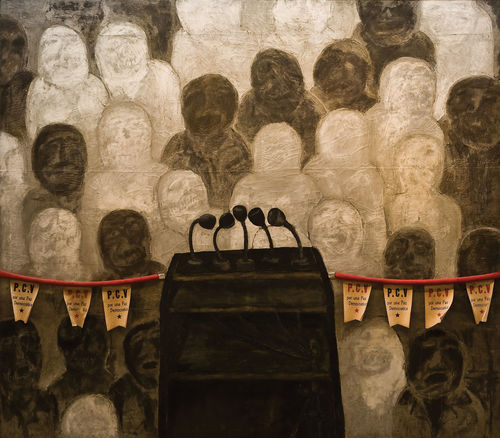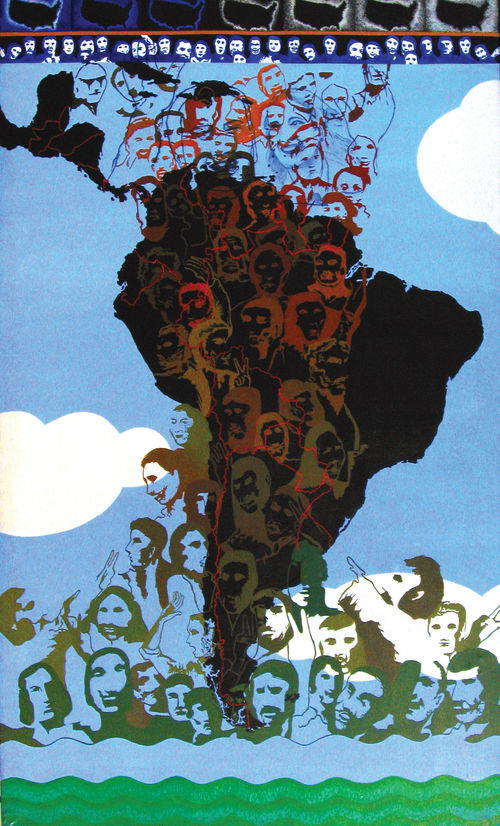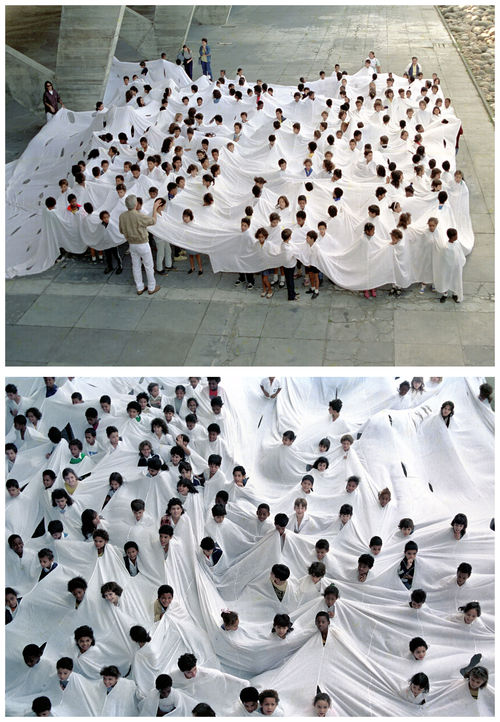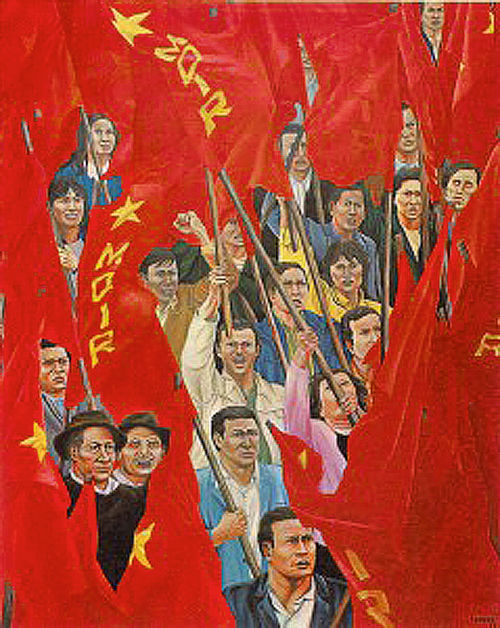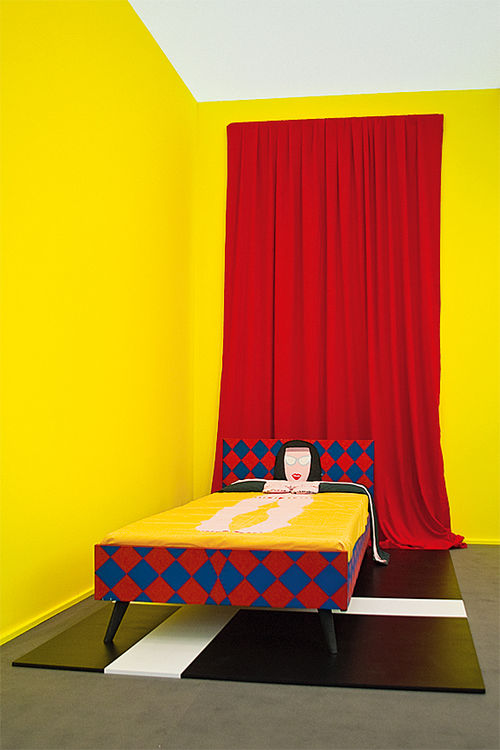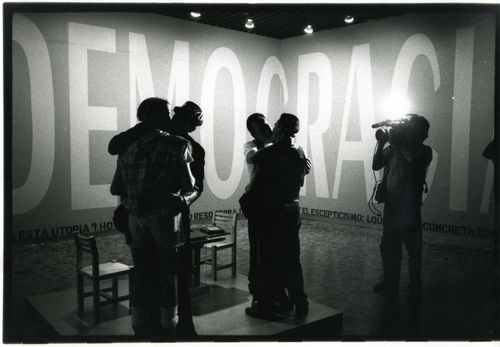The Iconographic Turn
In the 1960s artists began to produce novel representations of the body. At stake was a radical iconographic turn from established traditions. The hidden and unchanging body, the body beset by stereotypes or even by taboos linked to the patriarchal structures of heterosexual and normative modernism, was intensively questioned and investigated. A rediscovered body surfaced in the field of artistic representations both in Latin America and internationally (fig. 1). During the years encompassed by Radical Women: Latin American Art, 1960–1985, artists inverted the point of view from which the female body had previously been represented (the nude, the portrait, and images of motherhood, all seen from a certain angle, one anchored in parameters of representation regulated first by the conventions of nineteenth-century academic art and, later, by those of early twentieth-century modernism). Artists also engaged in systematic research on the basis of previously unexplored agendas. By means of materials, substances, and languages never before used, they undermined existing systems of representation. Their interventions revolved around a destructuring of the social formats that regulated the body. This led to the emergence of a new body in which the former body, the culturally established body, was shattered.
Denaturalized and stripped of social morality and—more specifically—of biological function, this new conception of the body ushered in knowledge that unleashed sensibilities not previously expressed in images—at least not as part of such a widespread, multiplex, and simultaneous project. That project was not tied to a single unified agenda, however, but was formulated in different contexts on the basis of specific historically and culturally situated strategies.
![Fig. 1. Annemarie Heinrich, Veraneando en la ciudad (Summering in the city [Buenos Aires]), 1959](/sites/default/files/styles/archive_media/public/migrated-assets/media/Digital_archives/Radical_Women/Essays/02_giunta_fig1.jpg?itok=7CrFcA1t)
The body was, in general terms, at the center of political, social, and aesthetic agendas in the 1960s, 1970s, and 1980s. In philosophy and theory that meant observation and analysis of the socially regulated and monitored body and of sexuality as the great narrative with which the West organized and stigmatized difference, perspectives formulated by Michel Foucault in his fundamental books Discipline and Punish: The Birth of the Prison (1975) and The History of Sexuality (1976–84).# Like an oil spill, that awareness of the body spread in the cultural field and, with particular intensity, in artistic representations. Starting in the 1960s and through the 1980s, Latin American and Latina artists classified by society as women (regardless of their individual gender identifications or self-representations) produced experimental artworks that introduced radical changes in how the body was represented. Indeed, the artistic research that ensued was so intensive that I would even argue that feminist artists and artistic feminism—the historiographic position from which I analyze the work of these women artists—enacted the twentieth century's greatest iconographic transformation.#
Disarmed by devices that deauthorize terms like woman, feminism, and women artists, Latin American women artists are not bound generationally to the feminist art movement that developed in the United States, for instance.# Their identification with the political scene was overwhelmingly shaped by a commitment to revolutionary struggle and resistance to the region's dictatorships. Regardless, in their works they explored the repertoire of issues that feminism addressed. Though they did not call themselves feminists, they undertook intensive research into subjectivity and the problematic status of women in society and as biologically and culturally conditioned beings. In that sense Latin American women artists subverted systems of representation wholesale. The body was the battlefield from which they launched new knowledge in which performance was a privileged instrument.
My use of the term women artists by no means implies that I endorse classifications based on biological essentialism. What I attempt to make visible is the fact that society deploys biological classification to differentiate between women and men, regardless of their sexual choices. The art system has discriminated against those artists that it classifies as women, rendering them invisible. With a repertoire that questioned that essentialism, the works produced by women artists represented other bodies and other sexualities, reflecting the agendas of identity and difference that gained political strength starting in the late 1980s as alternative ways of understanding bodies emerged. Their interventions made it possible to envision aesthetics that questioned patriarchal values. Those poetics critically engaged the problem of sexual identity, making way for lesbian, gay, queer, trans, and other aesthetics as processes that desolidify normative representations of sexuality. That diversity has been named and explored in recent years pursuant to the development of complex theories of gender. That does not mean, however, that the artists represented in this exhibition adhered to or were aware of the differentiations that I establish here, drawing on current debates and theoretical instruments.
In the case of Latin America, the relationship between body and violence is central. Dictatorships and repressive apparatuses in the region subjected bodies to notions of punishment indifferent to the frameworks established by the concept of humanity that—as Foucault analyzes in Discipline and Punish—took hold in modern Europe starting in the eighteenth century.# The conventions of the economy of discipline and punishment established by modern prison and education systems exploded in the context of the Latin American dictatorships, ushering in widespread violence that did away with the structures of institutional control. Illegal detention, torture, births at secret detention centers, and the theft of children whose whereabouts are, in many cases, still unknown: these are some of the circumstances that marked the situation of the body in general and of the bodies of women in particular under dictatorships in Latin America.# Some artists were imprisoned or forced to seek exile: the Uruguayan artists Leonilda González and Lacy Duarte were imprisoned, and Duarte, Diana Mines, and Teresa Trujillo were exiled. The Chilean artist Cecilia Vicuña and the Argentine artist Marcia Schvartz lived abroad during the dictatorships in their countries.# Specific methods of torture were enacted on women's bodies. In their works these artists addressed, in different ways, the status of the female body under violent and repressive political structures, as well as the state of society as a whole under dictatorship.#
In that cultural and political framework, the work of the artists brought together in this exhibition destructured and rendered poetically visible the social formats that regulated bodies. Topics steeped in stereotypes were addressed from a critical perspective. Motherhood was stripped of affect and envisioned beyond authorized categories in order to be grappled with as problematic. Motherhood's aura was undermined by investigations in diary format (Lea Lublin); it was rendered through the repeatable experience of birth as trauma (Lygia Clark); gestating bodies were exhibited as sculptural material that appealed to the abject (Johanna Hamann); birth was made into a damp, fluid, and transformative experience (Yeni y Nan); the artists' own pregnancies were exhibited in relation to violence (Marta María Pérez). Anticipating agendas that began developing mostly in the 1990s, these artists dismantled gestating bodies, as well as full bellies and symptoms of pregnancy, to turn them into devices that could act on any body, thus queering, in a sense, motherhood (Polvo de Gallina Negra). Motherhood was also socialized, poetically in the case of Graciela Gutiérrez Marx's postal action, which was an invitation to celebrate her mother's birthday. With striking images and performances, artists condemned the crime of rape (Ana Mendieta, Josely Carvalho).
Through their representations these artists subverted the portrait genre. They intervened into it using the cataloging device of ID photos and mug shots or tourist snapshots; they meddled with it through medical discourse (Teresa Burga); using the cultural materials gathered in their studios, they produced insinuated, rather than representational, portraits (Narcisa Hirsch); they covered their faces with ink, rendering them as printing matrixes or masks (Nelbia Romero); they assumed satirical expressions to display different moods (Mónica Mayer, Regina Vater); they questioned assigned social identities (Marisol); they challenged the limits of religion by representing themselves as the Virgin of Guadalupe (Yolanda López); they showed themselves climbing the same staircase again and again in an endless search (Margarita Morselli). By means of the self-portrait, they interrogated identities in transit, displaced indigenous identities (Anna Bella Geiger), and considered major female figures like Gabriela Mistral, the only Latin American woman writer to be awarded the Nobel Prize (Roser Bru). They captured faces threatened by the violence of menacing scissors (Anna Maria Maiolino) or by suffocating nets (Cecilia Vicuña). They used visual conventions to signal the limitations that society places on the female subject (Marie Orensanz). The portrait genre was strained in a critique of the stereotypes of middle- and upper-class Colombian society (Clemencia Lucena); it was the foundation from which patriarchal structures were questioned to propose matriarchal alternatives (Judith F. Baca). The face became the territory of subtle interrogations posited in the friction between drawing and photography (Liliana Porter). The self-portrait and the portrait put forth questions, subjectivities, paradoxes formulated by female subjects rising up against canonical representations of the female face throughout art history.
The portrait was also the form of representation used to address the violence of the region's dictatorships: the faces of the disappeared (Roser Bru, Luz Donoso); the faces of one's own children as a way to measure the time of dictatorship (Paz Errázuriz, Julia Toro); the faces and bodies of the tortured (Olga Blinder, Sonia Gutiérrez). In some works the portrait is also associated with the violence waged against Native American peoples, whether exterminated (Nelbia Romero) or rendered exotic in, for instance, the format of a postcard in which Anna Bella Geiger photographed herself dressed as an indigenous woman. Other works explored tensions between indigenous populations and a state that did not regard them as legitimate citizens (Claudia Andujar). Only exceptionally was race introduced as resistant consciousness: in one of her performances, the Peruvian artist Victoria Santa Cruz shouted the words "black woman!" and "I am black!" confrontationally to name the Afro–Latin American subject and experience. That work makes visible the process that expels those not categorized as having what is considered the right skin color.
Steeped in social politicization but also in the politics of the redefined and urban collective body, some works represent the masses. The crowd listening to an absent orator (Antonia Eiriz; fig. 2); the crowd that signals the onset of a new historical age in Latin America (Elda Cerrato; fig. 3); and the crowd that emerges in the tension between bodies and the textile material that restrains them (Lygia Pape; fig. 4). Others present body as multitude and body multiplied, as in the work of Gracia Barrios; indoctrinated bodies like the one Clemencia Lucena showed us in work she began producing in the 1970s (fig. 5); persecuted bodies like those portrayed by Patssi Valdez in images that defy stereotypes of Chicana women and the sexual threat they have experienced at the hands of the police.
The works in the exhibition address a range of complexities, some of them tied to unrepresentable and taboo bodily substances, to that which is expulsed as repugnant (bodily tissue, menstrual blood, urine, excrement), substances that call forth an emotionality that places before us the subaltern other.# In repulsion, we can see ourselves as different and as at a distance from the other. Blood naturalizes on the basis of biological difference and elicits the emotionality of the abject.# Blood, urine, excrement, and saliva erupt as substances indicative of culturally determined bodies (Lygia Clark, Ilse Fuskova, Ana Mendieta, María Evelia Marmolejo, Sophie Rivera). Blood is the phantasmal other that terrifies us. With the spread of AIDS in the 1980s, blood was also charged with a renewed and penalized otherness, the basis for a new regulation of correct sexualities (Liliana Maresca; fig. 6).
The abject drive makes itself felt in actions that both border on the domestic and move away from it. This is the case, for example, in a work by Sybil Brintrup and Magali Meneses in which they prepare seafood for lunch, or in Regina Silveira's cookie in the shape of the Portuguese word arte (art), which appeals to the mouth and the act of ingesting—a work intended to be devoured. Food, lips, and mouths are a means to reposition violence when, in the context of the Chilean dictatorship, two girls lick popsicles to uncover toy soldiers (Gloria Camiruaga). Slimy substances steeped in saliva are eaten, digested, and expelled on a prostrate body that is then reborn with new perceptions in Lygia Clark's Baba antropofágica (Anthropophagic slobber, 1973). In Sylvia Salazar Simpson's performative works, she covers her head with food or other organic substances.
In many works in this exhibition, the female body undergoes a fragmentation that dissolves the patriarchal gaze. Rather than one body, these works posit the possibility of many bodies—splintered bodies. Some are analogical pieces, "masks" of fragments of broken casts from the traumatology department of a hospital (Dalila Puzzovio) or the masks of a face that, one after another, María Martínez Cañas removes; bellies hanging from hooks like pieces of meat at a butcher shop (Johanna Hamann); the body inspected microscopically, cells and vaginas revealed in a provocative anatomic-scientific cosmogony (Mercedes Elena González); the body fragmented in rough hand-made ceramic pieces turned into a part to be assembled (Tecla Tofano); the body viewed as fragments of skin enlarged to give shape to a landscape (Vera Chaves Barcellos). In these works the body ceased forever more to be a unit that could be controlled from a single point of view.
Bodies are administered as well by the institutional norms of art in a format reminiscent of biopolitical control in a work by the Argentine artist Graciela Carnevale in which she locked viewers into an exhibition venue, thus staging the repressive situation in Argentina during the Onganía dictatorship (1966–70). When, in a ritual gesture, Lotty Rosenfeld knelt on the street time and again to draw lines across the asphalt's dividing lines, thus making crosses or plus signs, her action could be read in relation to the sacrificial state of the body under dictatorship; Isabel Castro produced the series Women under Fire (1980) as a form of protest against the forced sterilization of Chicana women.
The body was investigated through forms of eroticism and devices associated with sexuality. Beds were understood not as support for the nude laid out for male desire but as an invitation to erotic motion (Feliza Bursztyn), to lose control (Marta Minujín's mattresses), or as commentary on the bed as place of submission (Teresa Burga; fig. 7)—an understanding that also makes itself felt in some scenes in María Luisa Bemberg's feminist film El mundo de la mujer (Woman's world, 1972). An exploration of eroticism as play, as box in which to love (Teresinha Soares); frontal nudity as expression of contempt (Marcia Schvartz; fig. 8); eroticism as means to represent broken feelings (Delia Cancela) or as reflection on women's reproductive apparatus (Margot Römer). Many works declassified the normalcy of affects in pursuit of unruly kisses, kisses that create friction between skins marked by differences of class and of hygiene (when, for instance, Diamela Eltit kisses a homeless man), revolutionary kisses (Cecilia Vicuña), or kisses at the center of the museum turned into artwork-action (Mónica Mayer and Víctor Lerma; fig. 9).
In their works women artists undertook in-depth research into the social place of women. They looked to the discourses of sociology, designing and carrying out or analyzing surveys on what women abhor about how they are treated in the city and in its speech (Mónica Mayer) or interrogating the relationship between real women in a specific location like Peru and stereotypical views of women (Teresa Burga). Their socially oriented research took on specific forms of participation in the consciousness-raising groups deployed in the 1970s, which tied feminist politics to psychoanalysis (Narcisa Hirsch). Those formats of exchange led to group performances, like the ones that Mayer developed for North American and Mexican feminist artists.
The privileged interlocutors of these artists' research into sociability were viewers who were invited, in a variety of ways, to participate in their works. Indeed, the word participation was key to the poetics of the 1960s and 1970s. It made itself felt in the surveys designed by Mayer, in Liliana Porter's invitation to crumple pieces of paper with one's own hands, in Carnevale's manipulation of bodies by locking them in a space, in Marta Minujín and Rubén Santantonín's invitation to play and to explore a space in La menesunda (Mayhem, 1965), in Lygia Clark's therapies with perceptual objects, in the food laid out and devoured in Hirsch's Marabunta (Swarm, 1967), and in Margarita Azurdia's invitation to remove one's shoes in order to feel wet sand.
At stake as well was in-depth research into female subjectivity. Maps of desires, drives, repressed zones reminiscent, perhaps, of Jacques Lacan's diagrams (Anna Maria Maiolino); questionings of medical classifications of female hysteria (Feliza Bursztyn); and ironic references to the Freudian notion of penis envy (Maris Bustamante). In an effort to escape, perhaps, those ways of filtering female sensibility, Sandra Llano-Mejía proposed direct contact with the rhythms of one's own body in In pulso (In pulse, 1978). Placing an electrocardiograph in the Museo de Arte Moderno in Bogotá, she invited museum-goers to take "printouts of their cardiac emotions" away with them.#
The body of the artist came on the scene as expressive material. Contemporary dance and corporeal expression intervened in the paradigm of the normalized body of classical ballet and mingled with the materials of the visual arts (Ana Kamien, Marilú Marini, Teresa Trujillo, Martha Araújo, Sylvia Palacios Whitman). Vibrating nude bodies stood in stark contrast to the oppressive atmosphere of Mexico City (Pola Weiss); bodies cross-dressed to render visible the extermination of the Charrúa people in the founding of the Uruguayan state (Nelbia Romero); bodies also evidenced the endangered existence of the Yanomami people in Claudia Andujar's series Marcados (Marked, 1981–83). With these works artists addressed zones negated by the colonial histories of the new Latin American republics.
As splinters of bodies, sensibilities, and concepts, these works give us a sense of a different knowledge, of new languages and affects. Were it not for this rediscovery of the body and release from the corset of essentialism that tied sexuality to biology, it may well have proven impossible to enable the range of sensibilities and sexual choices inhabited by bodies, even in a society in which they are divided into feminine and masculine. The revolution of bodies enacted by women artists and by feminism enabled the agendas and forms of visualization of choices formulated today by members of the lesbian, gay, trans, and gender-nonconforming communities and problematized in gender and queer studies, whose cultural analyses undermine essentialisms. The intensive investigation of transgressions in these works provided and activated a reservoir that questions ahistorical conclusions that date the origin of those agendas to the late 1980s. As always, history allows us to go beyond commonplace and pat conclusions that do not heed lived experiences or the wealth of strategies devised by those who came before us.
Radical Women investigates the historicity that, through images, made it possible to conceive new ways of addressing representations of bodies, declassified representations open to the crossing of sensibilities previously drawn as hygienically separate. Rather than asking what these women artists lost in terms of their representation in the art field, we ask what we have all lost by not being able to experience or to see many of the works hidden away from exhibition spaces. This new knowledge had an emancipatory effect on viewers and on artists, bearers—since the decades encompassed by this exhibition—of knowledge that allowed them to grasp the complexity of their affects and of their bodies.# That knowledge released a power, an authority, for those once subjected to schemes of representation that regulated representations of correct bodies—mostly, here, those bodies that society classifies as female. These works gave shape to a process of decolonization of bodies and systems for the validation of art; they questioned modernism's patriarchal aesthetic system in a process of reformulation still under way. That knowledge challenged the limits of institutions that today draw sustenance from and reenvision themselves in terms of that explosion of the canon. Thus, artistic feminism and feminist criticism of art history contributed to the reworking of aesthetic values and of representations of bodies still vital to us. They liberated the representation of desire. They provided new knowledge that promises endless expansion, expansion of the foundations of our sensibility that will undoubtedly further the aesthetic emancipation of citizens.
Michel Foucault, Discipline and Punish: The Birth of the Prison, trans. Alan Sheridan (London: Penguin, 1977), and Foucault, The History of Sexuality, trans. Robert Hurley, 3 vols. (New York: Pantheon, 1978–86). Discipline and Punish and The History of Sexuality represented a complex systematization of the analysis of systems to control bodies, about which awareness began to develop in the postwar years. Feminism and representations of the female body in art formed part of that process. Prison techniques and their application to society as a whole, which Foucault analyzed on structural and historic levels, as well as his analysis of the relationship between sexuality and the control of living bodies, evidence the centrality of the body as space of reflection starting in the 1960s and through the present.
I establish a difference between feminist artists and artistic feminism. I consider feminist artists those creators who deliberately and systematically attempted to build a feminist artistic repertoire and language (most of them were also feminist activists). I use the term artistic feminism to refer to the position of the historians who study art from the perspective of the feminist agenda. That might mean salvaging artists largely invisible—and, in doing so, contributing to the emergence of a history of feminist art—or analyzing systems of representation linked to feminist agendas even when the artists themselves do not identify as feminists or consider their work feminist. This perspective is linked to gender studies that consider sexuality to be a social construction. Historical methodology requires not calling all works produced by women feminist art.
As this catalogue explains, there were exceptions: the Mexican artists Mónica Mayer, Maris Bustamante, and Ana Victoria Jiménez; the Venezuelan artist Tecla Tofano; and the Argentine artist María Luisa Bemberg were feminist activists. Among Latina artists in the United States, feminists include Josely Carvalho and Sophie Rivera and the Chicana artists Judith F. Baca, Barbara Carrasco, and Isabel Castro. After the period encompassed by this exhibition, other Latin American women artists organized shows tied to feminism as well as collectives in which they produced committed activist art.
A brief chronology of such regimes in the region would include Paraguay (1954–89), Brazil (1964–85), Argentina (1966–70, 1976–83), Peru (1968–80), Bolivia (1971–78), Chile (1973–90), and Uruguay (1973–85). This history of extreme violence would encompass as well the civil war in Guatemala (1960–96), which witnessed the overthrow of a number of regimes; more than two hundred thousand people were killed, mostly indigenous people and women, in a war whose origin lay in the 1954 coup d'état. El Salvador also experienced a civil war in the 1980s that left more people dead and disappeared than any other single event in the country's history. This brief reference to a history of violence that included the disappearance of persons must further mention Operation Condor, a plan supported by the United States whereby, during the 1970s and 1980s, the actions of the leaders of the dictatorships in South America (Argentina, Bolivia, Brazil, Chile, Paraguay, Uruguay, and—sporadically—countries like Colombia, Ecuador, Peru, and Venezuela) were coordinated. See Wikipedia, s.v. "Operation Condor," last modified February 7, 2017.
Argentina is a country with a high number of disappeared children during the dictatorship. Thanks to the tireless and systematic work of the human rights organization Abuelas de Plaza de Mayo, so far some 120 of an estimated total of 500 children who disappeared during the dictatorship have been identified and located. See the organization's website, https://www.abuelas.org.ar/, and "Abuelas de Plaza de Mayo presentan al nieto recuperado 120 en Argentina," El País (Uruguay), June 29, 2016.
Schvartz lived in Barcelona and Vicuña in London, where she waged an intensive campaign against the Pinochet dictatorship that has since been compiled and analyzed by Paulina Varas, in Artists for Democracy: El archivo de Cecilia Vicuña (Santiago, Chile: Museo Nacional de Bellas Artes and Museo de la Memoria y los Derechos Humanos, 2014).
The bibliography on this topic is extensive, especially in Argentina, Chile, and Uruguay: Paz Rojas, Patricia Barceló, and Katia Reszczynski, Tortura y resistencia en Chile: Estudio médico-político (Santiago, Chile: Emisión, 1991); Pilar Calveiro, Poder y desaparición: Los campos de concentración en la Argentina (Buenos Aires: Colihue, 1996); Memoria para armar uno: Testimonios coordinados por el Taller de Género y Memoria ex-Presas Políticas (Montevideo: Senda, 2001); Marisa Ruiz, Ciudadanas en tiempos de incertidumbre: Solidaridad, resistencia y lucha contra la impunidad (1972–1989) (Montevideo: Doble Click, 2010); Analía Aucía et al., Grietas en el silencio: Una investigación sobre la violencia sexual en el marco del terrorismo de estado (Argentina: CLADEM, Instituto de Género, Derecho y Desarrollo, 2011); Javier Maravall Yáguez, Las mujeres en la izquierda chilena durante la Unidad Popular y la dictadura militar (1970–1990) (Madrid: Universidad Autónoma de Madrid, 2012); and Blanca Emeric, Mujeres a la sombra y mujeres en la sombra (Montevideo: Nordan-Comunidad, 2013). On more recent forms of violence inflicted on women's bodies, see Rita Laura Segato, La escritura en el cuerpo de las mujeres asesinadas en Ciudad Juárez (Buenos Aires: Tinta Limón, 2013). On the women's prison system in Argentina, see Mujeres en prisión: Los alcances del castigo (Buenos Aires: Siglo Veintiuno; Centro de Estudios Legales y Sociales; Ministerio Público de Defensa; and Procuración Penitenciaria de la Nación, 2011). In 2000 Gloria Camiruaga, a video maker featured in this exhibition, made the documentary La venda (The blindfold), which included the testimony of women tortured during the Pinochet dictatorship in Chile.
Gayatry Chakravorty Spivak, "The Rani of Sirmur: An Essay in Reading the Archives," History and Theory 24 (October 1985): 247–72.
Julia Kristeva, Powers of Horror: An Essay on Abjection, trans. Leon S. Roudiez (New York: Columbia University Press, 1980), 2.
Sandra Llano-Mejía, interview with Carmen María Jaramillo, February 5, 2016; see also Jaramillo's essay in this volume.
I refer to emancipation in the sense of a new knowledge that is a construction or elaboration of skills developed on the basis of the relationship between what artists propose, on the one hand, and viewers, on the other. What arises is a third knowledge that belongs to neither, a knowledge that always questions the idea of sameness. See Jacques Rancière, The Emancipated Spectator, trans. Gregory Elliott (London: Verso, 2011). In that sense I understand that the wealth of experiences offered by the works in this exhibition, many of them performative, transforms the relationships of identity that we once had with bodies. And that produces liberating knowledge. Indeed, the traditional definition of that term is operative, that is, liberating knowledge understood as action that affords a person or a group of persons access to autonomy once denied them by an authority that subjected their skills. Liberating the body from stereotypes contributed to the legal, political, professional, social, familial, and personal equality that women had been denied and that the feminist agenda has pursued starting with its first incarnations in the nineteenth century and through more recent and contemporary versions. Much of the feminist agenda is still pending.


